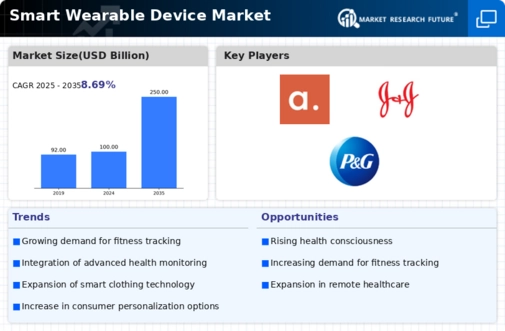Market Growth Projections
The Global Smart Wearable Device Market Industry is projected to experience substantial growth, with estimates indicating a market size of 100 USD Billion in 2024 and a remarkable increase to 250 USD Billion by 2035. This growth trajectory suggests a compound annual growth rate of 8.69% from 2025 to 2035, highlighting the increasing consumer interest and technological advancements in the sector. As wearables become more integrated into daily life and health management, the market is likely to expand, driven by innovations and evolving consumer preferences.
Technological Advancements
The Global Smart Wearable Device Market Industry is propelled by rapid technological advancements, particularly in sensor technology and connectivity. Innovations such as improved biometric sensors and enhanced battery life are making devices more efficient and user-friendly. For instance, the integration of artificial intelligence in wearables allows for personalized health insights, which is increasingly appealing to consumers. As technology evolves, the market is projected to reach 100 USD Billion in 2024, reflecting a growing consumer base that seeks cutting-edge features in health monitoring and fitness tracking.
Health and Fitness Awareness
Rising health consciousness among consumers significantly drives the Global Smart Wearable Device Market Industry. Individuals are increasingly adopting wearables to monitor their health metrics, such as heart rate, sleep patterns, and physical activity levels. This trend is supported by a growing emphasis on preventive healthcare, which encourages people to take proactive steps towards their well-being. The market's expansion is evident as it is expected to grow to 250 USD Billion by 2035, indicating a robust demand for devices that facilitate healthier lifestyles and provide real-time health data.
Integration with IoT Ecosystem
The integration of smart wearable devices with the Internet of Things (IoT) ecosystem enhances their functionality and appeal, thereby driving the Global Smart Wearable Device Market Industry. Wearables that connect seamlessly with smart home devices and smartphones offer users a cohesive experience, allowing for better data synchronization and control. This interconnectedness not only improves user engagement but also fosters innovation in product development. As the IoT landscape continues to expand, the market is anticipated to witness a compound annual growth rate of 8.69% from 2025 to 2035, indicating a promising future for connected wearables.
Increased Adoption in Healthcare
The healthcare sector's increasing adoption of smart wearable devices is a pivotal driver for the Global Smart Wearable Device Market Industry. Medical professionals are leveraging wearables for remote patient monitoring, which enhances patient care and reduces hospital visits. Devices that track vital signs and provide real-time data are becoming essential tools in managing chronic conditions. This trend is likely to contribute to the market's growth trajectory, as healthcare systems recognize the value of integrating technology into patient management. The market's expansion reflects a broader shift towards digital health solutions that prioritize patient engagement and data-driven decision-making.
Consumer Demand for Personalization
Consumer demand for personalized experiences is a significant driver of the Global Smart Wearable Device Market Industry. As users seek devices tailored to their specific needs, manufacturers are responding with customizable features and designs. This trend is evident in the proliferation of wearables that allow users to select functionalities based on their lifestyle preferences, such as fitness tracking or sleep monitoring. The ability to personalize devices enhances user satisfaction and loyalty, which is crucial in a competitive market. As personalization becomes a standard expectation, the market is poised for continued growth, reflecting changing consumer behaviors.




